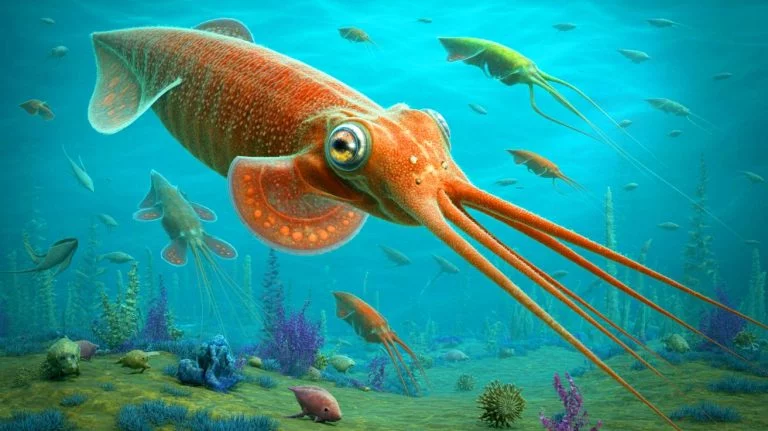| IN A NUTSHELL |
|
In a groundbreaking discovery, researchers have finally unraveled the mystery of the ancient squid-like creatures known as nectocaridids. For decades, these enigmatic marine organisms puzzled scientists with their squid-like appearance and presumed ancestry. However, recent findings from fossils unearthed in North Greenland have revealed a surprising truth: nectocaridids are not ancestors of cephalopods as once thought. Instead, they are early descendants of arrow worms, a revelation that reshapes our understanding of the evolutionary tree. This discovery highlights the dynamic nature of scientific inquiry and how new evidence can challenge long-held assumptions.
The Quest for Answers in Greenland
Dr. Jakob Vinther from the University of Bristol has long questioned the prevailing notion that nectocaridids were early cephalopods. His skepticism stemmed from inconsistencies between the anatomy of nectocaridids and what was known about cephalopods. About 15 years ago, a study based on Burgess Shale fossils claimed that these creatures were indeed cephalopods. However, Vinther found this claim unconvincing, prompting further investigation.
The search for answers led paleontologists to the Sirius Passet fossil site in Greenland, known for its exceptional preservation of marine organisms from the Early Cambrian period. The conditions at Sirius Passet allow for the preservation of even the softest parts of ancient organisms, providing a rare opportunity to study their intricate structures. It was here that the team uncovered 25 well-preserved nectocaridid fossils, which ultimately provided the definitive proof needed to solve the mystery.
Revealing the Nervous System
One of the most significant breakthroughs came from the preservation of delicate nervous system tissues within the fossils. Dr. Vinther and his team discovered that the nectocaridids preserved parts of their nervous system as paired mineralized structures, a feature not found in cephalopods but indicative of arrow worms. This crucial detail served as the missing link, confirming that nectocaridids were indeed descendants of arrow worms (chaetognaths), rather than ancestors of cephalopods.
The identification was made possible by the unique preservation of the ventral ganglion, a large mass of nerves located on the belly of living arrow worms. This feature, along with other anatomical similarities to fossil chaetognaths like Timorebestia and Amiskwia, solidified the classification of nectocaridids within the chaetognath stem lineage. The discovery underscores the complexity and diversity of ancient marine life and highlights how evolutionary pressures can lead to similar adaptations across different lineages.
A Glimpse into Ancient Marine Life
The revelation that nectocaridids are early descendants of arrow worms rather than cephalopods offers new insights into the evolutionary history of marine life. These creatures, with their sophisticated “camera eyes” and long antennae, were complex predators that played a significant role in the ancient food chain. They were active, stealthy swimmers, much like modern squids, but their lineage diverged long before the emergence of true cephalopods.
This discovery challenges our understanding of how certain features, such as squid-like appearances, can evolve independently in different lineages due to similar ecological pressures. It also highlights the evolutionary potential of simple organisms like arrow worms, whose ancestors possessed intricate anatomies and complex behaviors. The nectocaridid fossils offer a window into a world where ancient marine predators thrived, showcasing the diverse forms life can take.
A Tribute to an Enigmatic Creature
The newly identified fossil, Nektognathus evasmithae, honors Professor Eva Smith, a renowned human rights advocate. This naming pays tribute to her contributions and reflects the unique nature of the creature it represents. According to Dr. Vinther, Nektognathus was a “smart and stealthy fighter,” embodying the complexity and adaptability of early marine predators.
The role of these swimming worms in ancient ecosystems was more significant than that of their modern-day relatives. As active predators, they occupied a higher position in the food chain, preying on other marine organisms. Their existence sheds light on the evolutionary pathways that led to the diverse array of life forms we see today, and their story serves as a reminder of the ever-changing nature of life on Earth.
As we continue to uncover the secrets of the past, each discovery adds a new layer to our understanding of evolution and the intricate web of life. How might these revelations about ancient marine life influence our perspective on evolutionary biology and the future of scientific exploration?
Did you like it? 4.3/5 (22)





Wow, who would’ve thought these “squids” were actually descendants of arrow worms? Nature never ceases to amaze! 🤯
Is it just me, or do scientists keep getting things wrong more often these days? 🤔
Thank you for this enlightening article. Science is truly an ever-evolving field.
So, does this mean we need to rewrite our textbooks again? 📚
How did they even figure this out from just fossils? The details are mind-boggling!
I’m not buying it. Sounds like another “scientific breakthrough” that’ll be debunked soon. 😒
Another reason to visit Greenland! Fossils and stunning landscapes. 🏔️
This is like finding out dinosaurs were just big chickens. 🐔
I’m glad they named it after Professor Eva Smith. It’s a nice tribute.
Is this a common occurrence in paleontology? Finding out that fossils are misclassified?
This is why science is fascinating. Never a dull moment! 🌟
My high school biology teacher would have loved this article!
Can someone summarize this in layman’s terms? I’m a bit lost. 😅
There were some fossils recently discovered that cleared up some questions about evolutionary transitions about 520 million years ago. These fossils from Greenland were field collected from Greenland between 2011 and 2017. The preparation, and analysis took years of work. They were remarkable in their clear representation of the original animals. *The field collection, and laboratory preparation are critical and the authors are very proud at their exceptional work.*
The key findings were that these fossils were from early ~519 million years old Cambrian deposits, and that they were ancestors of species living today. There are two related significant items. The first is that some sophisticated eyes and neuronal anatomy had evolved much earlier than we had known, The second is that there are living descendant organisms today.
The superior preparation methods, and analysis will be expected to be used in the future which makes the authors proud (and famous in their academic neighborhood) . The biggest excitement for the Science Advances authors seems to me to be that Steven J. Gould missed, and the new crew scored.
I bet the arrow worms are feeling pretty smug right now. 😂
Why is it always the squids or squid-like creatures that cause such a fuss? 🦑
Thank you for providing such well-researched content. I learned a lot today.
Great article! But could you explain more about these “ventral ganglions”?
Are there any more fossils like this waiting to be discovered?
Now I’m curious about what other creatures might have been misclassified. 🤔
This article made my day! I love learning about ancient marine life. 🌊
How sure are they about this new classification? Seems like a big leap.
This article has a bizarrely misleading title. There was no fraud, and no “humiliation.”
The interested reader should go to the actual science.
Jakob Vinther et al. 2025. A fossilized ventral ganglion reveals a chaetognath affinity for Cambrian nectocaridids. Science Advances 11 (30); doi: 10.1126/sciadv.adu6990
The Editors of Sustainability Times should wonder how their credibility is harmed, and even humiliated.
So, what’s next for these researchers? More trips to Greenland? 🇬🇱
This feels like a plot twist in a science fiction novel. Love it! 📖
Thanks for sharing this article. It’s a fascinating topic!
Why does this matter so much in the grand scheme of evolution?
Is there a chance this new finding could be proven wrong too? 🤷♂️
It’s amazing how much we can learn from fossils. Truly remarkable! 👏
How often do scientists find out they were wrong about something like this?
What every scientist hopes to do is find errors in prior work. The only thing better is to find something totally new.
Your headline is misleading and shows an incredible lack of understanding of how science works. The original studies used the best data available. These guys went back with new insights and found the data that let them make the connections to arrow worms. No one was humiliated, and the great science really needs to be highlighted.
Well said.
Excellent observation.
“Humiiated” Your choice of words belies the very nature of the scientific inquiry.